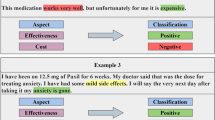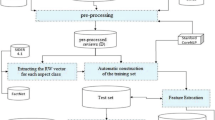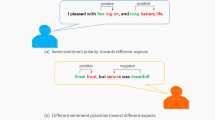Abstract
Aspect-based sentiment analysis has achieved many results in recent years, but most of the research focuses on goods, services, and topics. The research in the medical field is very limited. Considering the problem that the fish disease descriptions contain large numbers of emotional tendencies but the existing data are insufficient in this field, a dataset named Diseases of Fish Animals (DFA) is constructed. In this paper, we propose a feature interaction model based on an adversarial strategy to learn the relationship between aspects and texts by improving the attention mechanism. Aiming at the problem that the fusion effect is reduced due to the difference in feature distribution space during the interaction process, an adversarial strategy is designed to align text and aspect features. Experiments are carried out on the DFA dataset, which involves 7 aspects and 3 sentiment polarity and contains more than 4700 samples. The experimental results show that the accuracy and F1 of the model are 87.07% and 87.19% respectively. Although the model proposed in this paper achieves the best results on DFA, there is still a certain gap for precision medicine diagnosis and further efforts are needed.

Similar content being viewed by others
Data availability
No datasets were generated or analysed during the current study.
References
Alghunaim A (2015) A vector space approach for aspect-based sentiment analysis, Ph.D. thesis, Massachusetts Institute of Technology
Brown T, Mann B, Ryder N et al (2020) Language models are few-shot learners[J]. Adv Neural Inf Process Syst 33:1877–1901
Chen P, Sun Z, Bing L, Yang W (2017) Recurrent attention network on memory for aspect sentiment analysis. In: Proceedings of the 2017 conference on empirical methods in natural language processing, pp 452–461. https://doi.org/10.18653/v1/D17-1047
Devlin J, Chang MW, Lee K, Toutanova K (2019) Bert: Pre-training of deep bidirectional transformers for language understanding, ar**v preprint ar**v:1810.04805.
Ganin Y, Ustinova E, Ajakan H, Germain P, Larochelle H, Laviolette F, Marchand M, Lempitsky V (2016) Domain-adversarial training of neural networks. J Mach Learn Res 17(1):2096–2030
Gu J, Wang Z, Kuen J, Ma L, Shahroudy A, Shuai B, Liu T, Wang X, Wang G, Cai J et al (2018) Recent advances in convolutional neural networks. Pattern Recogn 77:354–377
Hong W, Li M (2019) A review:t ext sentiment analysis methods. Comput Eng Sci 41(04):750
Huang Z, Xu W, Yu K (2015) Bidirectional lstm-crf models for sequence tagging. https://doi.org/10.48550/ar**v.1508.01991
Jiang L, Li Y, Liao J et al (2023) Research on non-dependent aspect-level sentiment analysis[J]. Knowl-Based Syst 266:110419
Kusupati A, Bhatt G, Rege A et al (2022) Matryoshka representation learning[J]. Adv Neural Inf Process Syst 35:30233–30249
Li X, Bing L, Lam W, Shi B (2018) Transformation networks for target-oriented sentiment classification. https://doi.org/10.48550/ar**v.1805.01086
Lin T-Y, Dollár P, Girshick R, He K, Hariharan B, Belongie S (2017) Feature pyramid networks for object detection. In: Proceedings of the IEEE conference on computer vision and pattern recognition, pp 2117–2125. https://doi.org/10.1109/CVPR.2017.106
Ma D, Li S, Zhang X, Wang H (2017) Interactive attention networks for aspect-level sentiment classification. https://doi.org/10.48550/ar**v.1709.00893
Manandhar S (2014) Semeval-2014 task 4: Aspect based sentiment analysis. In: Proceedings of the 8th international workshop on semantic evaluation (SemEval 2014), pp 27–35. https://doi.org/10.3115/v1/S14-2004
Pennington J, Socher R, Manning CD (2014) Glove: Global vectors for word representation. In: Proceedings of the 2014 conference on empirical methods in natural language processing (EMNLP), pp 1532–1543. https://doi.org/10.3115/v1/D14-1162
Pontiki M, Galanis D, Papageorgiou H, Manandhar S, Androutsopoulos I (2015) Semeval-2015 task 12: Aspect based sentiment analysis. In: Proceedings of the 9th international workshop on semantic evaluation (SemEval 2015), pp 486–495. https://doi.org/10.18653/v1/S15-2082
Pontiki M, Galanis D, Papageorgiou H, Androutsopoulos I, Manand- har S, AL-Smadi M, Al-Ayyoub M, Zhao Y, Qin B, De Clercq O et al (2016) Semeval-2016 task 5: Aspect based sentiment analysis, in: ProWorkshop on Semantic Evaluation (SemEval-2016), Association for Computational Linguistics, pp 19–30. https://doi.org/10.18653/v1/S16-1002
Rahman MA, Kumar Dey E (2018) Datasets for aspect-based sentiment analysis in Bangla and its baseline evaluation. Data 3(2):15
Saeidi M, Bouchard G, Liakata M, Riedel S (2016) Sentihood: Targeted aspect based sentiment analysis dataset for urban neighbourhoods. https://doi.org/10.48550/ar**v.1610.03771
Tang D, Qin B, Liu T (2016) Aspect level sentiment classification with deep memory network. ar**v preprint ar**v:1605.08900
Wang Y, Huang M, Zhu X, Zhao L (2016) Attention-based lstm for aspect-level sentiment classification. In: Proceedings of the 2016 conference on empirical methods in natural language processing, pp 606–615. https://doi.org/10.18653/v1/D16-1058
Wang Y, Zhu J, Wang Z et al (2022) Review of applications of natural language processing in text sentiment analysis[J]. J Comput Appl 42(4):1011
Zhao A, Yu Y (2021) Knowledge-enabled BERT for aspect-based sentiment analysis[J]. Knowl-Based Syst 227:107220
Zhou J, Huang JX, Chen Q et al (2019) Deep learning for aspect-level sentiment classification: survey, vision, and challenges[J]. IEEE Access 7:78454–78483
Acknowledgements
The authors thank the anonymous reviewers for their valuable comments and suggestions.
Funding
This work was supported by basic research projects of higher education institutions of the Department of Education of Liaoning Province (LJKMZ20221095), key research and development projects of Liaoning province (2023JH26/10200015), and the 14th Five-year plan of educational science of Liaoning Province (JG21DB076).
Author information
Authors and Affiliations
Contributions
All authors contributed to the study’s conception and design. The first draft of the manuscript was written by Zihan Cong and all authors commented on previous versions of the manuscript. Sijia Zhang helped to improve the quality of the manuscript. All authors read and approved the final manuscript.
Corresponding author
Ethics declarations
Competing interests
The authors declare no competing interests.
Additional information
Handling Editor: Brian Austin
Publisher's Note
Springer Nature remains neutral with regard to jurisdictional claims in published maps and institutional affiliations.
Rights and permissions
Springer Nature or its licensor (e.g. a society or other partner) holds exclusive rights to this article under a publishing agreement with the author(s) or other rightsholder(s); author self-archiving of the accepted manuscript version of this article is solely governed by the terms of such publishing agreement and applicable law.
About this article
Cite this article
Cong, Z., Zhang, S. & Wu, J. Aspect-based sentiment analysis for fish diseases using a feature interaction model based on adversarial strategy. Aquacult Int (2024). https://doi.org/10.1007/s10499-024-01528-x
Received:
Accepted:
Published:
DOI: https://doi.org/10.1007/s10499-024-01528-x




